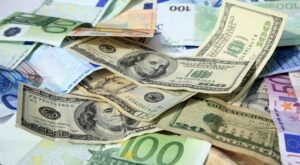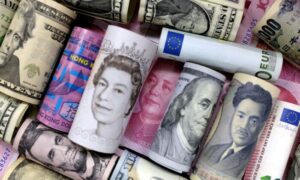
US dollar is stable against the euro, strengthening against the yen and the pound sterling on Friday.
The ICE-calculated index, which shows the dynamics of the dollar against six currencies (the euro, the Swiss franc, the yen, the Canadian dollar, the pound sterling and the Swedish krona), adds 0.03% during trading, the broader WSJ Dollar Index loses 0.02%.
The data of the US Department of Labor published the day before showed a weaker-than-expected slowdown in inflation. The CPI rose in September by 8.2% against the same month last year – the lowest rate in seven months. Experts polled by Trading Economics predicted, on average, a slowdown in inflation to 8.1% from 8.3% in August.
Meanwhile, core inflation, excluding the cost of food and energy (Core CPI) accelerated in September to the highest since August 1982 6.6% in annual terms from 6.3% a month earlier.
Published statistical data have strengthened investors in the opinion that the Federal Reserve System (Fed) will continue the rapid tightening of monetary policy. Now traders are waiting for a sharp rise in the rate of the US Central Bank at each of the two remaining meetings of this year, Bloomberg notes.
The euro/dollar pair is trading at $0.9781 compared to $0.9780 at the close of the previous session.
The US currency against the yen is 147.45 yen against 147.22 yen at the close of the market on Thursday.
The pound fell to $1.1322 from $1.1331 the day before.
British Treasury Secretary Kwazi Kwarteng left Washington, where he was meeting with representatives of the International Monetary Fund (IMF), a day earlier than planned. Experts believe that he may abandon part of the tax cuts he announced earlier in order to prevent an economic crisis in the country, the Financial Times writes.
The newspaper’s sources note that the IMF and finance ministers of several other countries recommended that he quickly abandon plans for tax cuts in order to avoid financial problems in the economy.

The dollar strengthens against the euro, yen and pound sterling in trading on Wednesday after a sharp decline the day before amid signals of a gradual decline in activity in the US economy.
Investors are waiting for data on the US labor market, which is expected to show a slowdown in job growth in the country. The consensus forecast of experts surveyed by Market Watch suggests that the number of jobs in September increased by 275 thousand (315 thousand in August), while maintaining unemployment at 3.7%.
The US Department of Labor will release the data on Friday at 3:30 p.m.
Another report from the Department of Labor, which was published on Tuesday, showed a sharp decrease in the number of open vacancies in the States in August. The indicator fell by 10% – the fastest pace since the start of the pandemic in 2020, to 10.1 million vacancies.
Weak statistics on the US economy are a good signal for risk appetite, as they speak in favor of a reduction in the trajectory of the Federal Reserve (Fed) rate hike, said Steven Innes, managing partner at SPI Asset Management.
Some “cooling” of the labor market will help ease inflation in the US and may reduce the need for further sharp tightening of monetary policy by the Fed, writes Dow Jones.
“If this trend continues, the Fed may back off somewhat in terms of rate hikes later this year and early next year,” said Jack Janasiewicz, portfolio manager at Natixis Investment Managers Solutions.
The euro/dollar pair is trading at $0.9966 on Wednesday, compared to $0.9987 at the close of previous trading. The pound fell to $1.1435 from $1.1475 at the close of previous trading.
The US dollar against the yen is 144.25 yen against 144.14 yen the day before.
On Tuesday, the dollar lost 1.7% against the euro, 1.4% against the pound and 0.3% against the yen.

The ICE-calculated index showing the dynamics of the dollar against six currencies (the euro, the Swiss franc, the yen, the Canadian dollar, the pound sterling and the Swedish krona) loses 0.11% during trading, the broader WSJ Dollar Index – 0.08%.
The euro/dollar pair is trading at $0.9846 compared to $0.9825 at the close of previous trading. The pound rose to $1.1361 compared to $1.1322 at the close of previous trading.
The US dollar against the yen is 144.75 yen against 144.56 yen the day before.
On Monday, the dollar lost 0.2% against the euro, 1.4% against the pound and 0.1% against the yen.
The weakening of the US currency was facilitated by statistical data showing a decrease in the index of business activity in the US manufacturing sector in September to the lowest level since May 2020. They were taken by the market as a signal that the Fed would have to stop the rate hike cycle earlier than expected in order to avoid a sharp decline in economic activity, Trading Economics notes.
The ISM Manufacturing Index fell to 50.9 last month from 52.8 a month earlier, according to the Institute for Supply Management (ISM). Analysts on average expected it to fall to 52.2 points, according to Trading Economics.
On Friday, September data on the US labor market will be released, which is expected to show a slowdown in US job growth. The consensus forecast of experts polled by Market Watch assumes an increase in the number of jobs in September by 275 thousand (315 thousand in August), while maintaining unemployment at 3.7%.
The dollar-denominated ICE index rose 7.2% in the third quarter, the biggest quarterly jump since 2015, according to Dow Jones data. In September, its value increased by 3.2%. The dynamics of the index for the whole of 2022 may be the best since 2014, when it grew by almost 13%.

The pound sterling again falls against the dollar due to renewed concerns about the British budget deficit amid announced tax cuts.
The pound by 9:05 a.m. fell 1% to $1.0782 compared to $1.0891 at the close of the previous session.
On the eve of the British currency rose after statements by the Bank of England about its intention to start buying long-term government bonds in an unlimited amount to stabilize the market, but the rise was short-lived.
Earlier this week, the pound hit a new all-time low against the dollar, and its fall since the beginning of the month could be a record since June 2016, when the British voted to leave the European Union.
The ICE-calculated index, which shows the dynamics of the US dollar against six currencies (the euro, Swiss franc, yen, Canadian dollar, pound sterling and the Swedish krona), rose by 0.85%, the broader WSJ Dollar – by 0.6%.
The euro/dollar pair is trading at $0.9668 compared to $0.9736 at the close of the session on Wednesday, the euro is losing about 0.7%.
The rate of the American currency against the yen increases by 0.4% and amounts to 144.64 yen compared to 144.12 yen the day before.
Meanwhile, the Chinese yuan is rising against the dollar for the first time in nine sessions. The yuan traded in mainland China rose to 7.1963/$1 from 7.2005/$1 at the close of the previous session.
The People’s Bank of China (PBOC, the country’s central bank) released a statement last night warning speculators that they would definitely lose money in the long run on betting on a weakening yuan and called on key market players to “protect the authority of the reference rate.”
The yuan on the mainland has fallen about 4% since the start of the month, and on Wednesday it hit a new low since 2008. Meanwhile, the offshore yuan traded in Hong Kong has fallen to its lowest level since the introduction of a separate trading system in 2010.

The pound sterling fell sharply against the US dollar during morning trading on Monday and hit a historic low on signals from the British Treasury about the likelihood of new tax breaks in addition to those announced last week.
The pound by 8:50 Moscow time fell by 2.6% and is $1.0570 compared to $1.0850 at the close of the previous session. Earlier in the day, the rate fell to $1.0327, which is the lowest level since 1971, when the UK switched to a decimal currency system.
Last week, UK Treasury Secretary Quasi Kwarteng announced a massive tax cut that will affect individuals and businesses and increase the budget deficit for the current fiscal year by more than 70 billion pounds.
“This government has only been in office for 19 days,” Kwarteng told the BBC on Sunday. “In the coming year, I would like to see people keep even more of their income because I believe the people of the UK will be the engine of the country’s economy.”
The market regarded this as a hint of new tax incentives, writes Bloomberg.
The ICE-calculated index, which shows the performance of the US dollar against six currencies (the euro, the Swiss franc, the yen, the Canadian dollar, the pound sterling and the Swedish krona), rose by 0.75%, exceeding 114 points for the first time since May 2020, according to Trading Economics .
The dollar is supported by the demand for defensive assets caused by fears of a global recession. In addition, currency traders point out that the Fed is tightening monetary policy at a faster pace than the rest of the world’s leading central banks.Pair pound / dollar has updated a historical low
The euro/dollar pair is trading at $0.9636 compared to $0.9690 at the close of the session last Friday, the euro loses about 0.6% and again updates the lows in two decades.
The rate of the American currency against the yen increases by 0.4% and amounts to 143.87 yen compared to 143.34 yen last Friday.